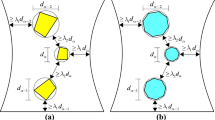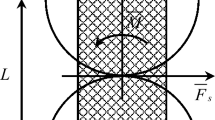Abstract
A multiphase mesostructure mechanical model is proposed to study the deformation and failure process of concrete considering its heterogeneity at the meso scopic level. Herein, concrete is taken as a type of three-component composite material composed of mortar matrix, aggregates and interfaces on the meso-scale. First, an efficient approach to the disposition of aggregates of concrete and a state matrix method to generate mesh coordinates for aggregates are proposed. Secondly, based on the nonlinear continuum damage mechanics, a meso-scale finite element model is presented with damage softening stress-strain relationship for describing the mechanical behavior of different components of concrete. In this method, heterogeneities of each component in the concrete are considered by assuming the material properties of three components conform to the Weibull distribution law. Finally, based on this multiphase meso-mechanics model, a simulation analysis of fracture behavior of a rock-fill concrete (RFC) beam is accomplished. The study includes experimental tests for determining basic mechanical parameters of three components of RFC and four-point flexural beam tests for verification of the model. It is preliminarily shown that the numerical model is applicable to studying failure mechanisms and process of concrete type material.
Similar content being viewed by others
References
Bentz D P, Schlangen E, Garbocz E J. Computer simulation of interfacial zone microstructure and its effect on the properties of cement-based composites. In: Skalny J, Mindess S, Eds. Materials Science of Concrete IV. Westerville: American Ceramic Society, 1995
Chandra S, Berntsson L. Interdependence of microstructure and strength of structural lightweight aggregate concrete. Cement Concrete Comp, 1992, 14(4): 239–248
Romstad K M, Taylor M A, Herrmann L R. Numerical biaxial characterization for concrete. J Eng Mech-ASCE, 1974, 100(5): 935–948
Wittmann F H. Structure of concrete with respect to crack formation. In: Wittmann F H, Ed. Fracture Mechanics of Concrete. New York: Elsevier, 1983
van Mier J G M. Fracture Processes of Concrete: Assessment of Material Parameters for Fracture Models. Boca Raton: CRC Press, 1997
Halm D, Dragon A, Charles V. A modular damage model for quasi-brittle solids-interaction between initial and induced anisotropy. Arch Appl Mech, 2002, 10(72): 498–510
Mohamed A R, Hansen W. Micromechanical modeling of concrete response under static loading-Part I: Model development and validation. ACI Mater J, 1999, 96(2): 196–203
Mohamed A R, Hansen W. Micromechanical modeling of concrete response under static loading-Part II: Model predictions for shear and compressive loading. ACI Mater J, 1999, 96(3): 354–358
Schlangen E, van Mier J G M. Lattice model for numerical simulation of concrete fracture. In: Proc Int Conf Dam fracture, Denver, Colorado, USA, 1991. 512–527
Tang C A, Zhu W C. Concrete Damage and Fracture-Numerical Simulate (in Chinese). Beijing: Science Press, 2003
Cundall P A, Strack O D L. A discrete numerical model for granular assembles. Geotechnique, 1979, 29(1): 47–65
Bazant Z P, Tabbara M R. Random particle models for fracture of aggregate or fiber composites. J Eng Mech-ASCE, 1990, 116(8): 1686–1705
Tang X W, Zhang C H. Simulation of meso-fracture for concrete based on the developed random aggregate model (in Chinese). J Tsinghua Univ (Sci Tech), 2008, 48(3): 348–351
GAO Z G. Study on Random Aggregate Structure and Computed Strength Problems for Nonhomogeneous Materials (Concrete) (in Chinese). Post Doctor Report, Tsinghua University. 2003
Wang J L, Liu T Y, Zhang C H. Simulation of cylindrical stone pile based on the material point method (in Chinese). J Tsinghua Univ (Sci Tech), 2005, 45(12): 1604–1607
Zhang C H, Wang G L, Wang S M, et al. Experimental tests of rolled compacted concrete and nonlinear fracture analysis of rolled compacted concrete dams. J Mater Civil Eng, 2002, 14(2): 108–115
Baznt Z P, Oh B H. Crack band theory for fracture of concrete. Materi Struct, 1983, 16(93): 155–177
Lee J, Fenves G L. Plastic-damage model for cyclic loading of concrete structures. J Eng Mech, 1998, 124(8): 892–900
van Mier J G M, van Vliet, Wang T K. Fracture mechanisms in particle composites: Statistical aspects in lattice type analysis. Mech Mater, 2002, 34(11): 705–724
Petersson P E. Crack growth and development of fracture zones in plain concrete and similar materials. Technological Report, TVBM-1006, Division of Building Materials, Lund Institute of Technology. 1981
Jin F, An X H. Construction method of large rock-filled dam (in Chinese). PRC Patent, ZL031026745, 2003
An X H, Jin F, Shi J J. Experimental study on self-compacting concrete filled prepacked rock (in Chinese). Concrete, 2005, (1): 3–6
Author information
Authors and Affiliations
Corresponding author
Additional information
Supported by the National Natural Science Foundation of China (Grant Nos. 90510018 and 90715041) and the National Basic Research Program of China (“973” Program) (Grant No. 2007CB714100)
Rights and permissions
About this article
Cite this article
Tang, X., Zhang, C. & Shi, J. A multiphase mesostructure mechanics approach to the study of the fracture-damage behavior of concrete. Sci. China Ser. E-Technol. Sci. 51 (Suppl 2), 8–24 (2008). https://doi.org/10.1007/s11431-008-6005-2
Received:
Accepted:
Published:
Issue Date:
DOI: https://doi.org/10.1007/s11431-008-6005-2




